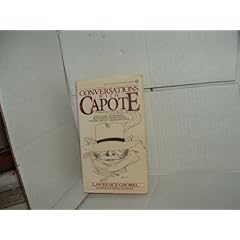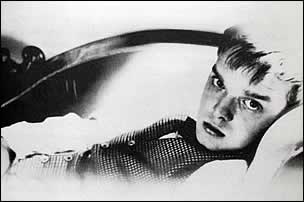
I started reading Lawrence Grobel's Conversations with Capote (Book #3) initially to get material for a paper on writers who crossed over to screenwriting. The book has been lounging in my shelf for such a long time now, and it wasn't for the paper, I wouldn't have cracked it open. Now I wish I did so earlier. I started reading it on the train home and didn't put it down until I finished it several hours later.
Truman Capote's In Cold Blood is one of my favorite books, and it's not entirely accidental that the book is about a very masterful account of a massacred family in the American midwest in the 1950s. He had this literary brawl with Norman Mailer, who hired researchers and wrote The Executioner's Song without actually talking to the subject. That got Capote railed about him, and he said that Mailer would never write anything that would be remembered in twenty years or so down the road.
But by the time the conversations with Grobel had taken place, Truman Capote had sort of devolved into a semi-regular talk show guest, the kind whose every syllable would turn out to be controversial.
Here's a photo that appeared in the book:

This was my first time to see this photograph of Capote; and I suppose, like everyone else, I was mesmerized by this photo of the reclining young man. A friend and I had this debate about which celebrity Capote resembled in his youth. I thought it reminded me of local actor Dingdong Dantes (terrible, I know), while my friend suggested a mix of Jack Black and Ewan McGregor.
At any rate, it was a controversial photo, one that catapulted Capote to the best seller list and made him a literary star. Wikipedia points us to Gerald Clarke, who in his Capote: A Biography (1988), wrote: "The famous photograph: Harold Halma's picture on the dustjacket of Other Voices, Other Rooms (1948) caused as much comment and controversy as the prose inside. Truman claimed that the camera had caught him off guard, but in fact he had posed himself and was responsible for both the picture and the publicity."
It's also this photo which made Andy Warhol become "madly in love" with Capote. Somewhere in the book, Capote says: "When he was a child, Andy Warhol had this obsession about me and used to write me from Pittsburgh... When he came to New York, he used to stand outside my house, just stand out there all day waiting for me to come out. He wanted to become a friend of mine, wanted to speak to me, to talk to me. He nearly drove me crazy."
Elsewhere, the photographer responsible for this photo recounted walking on Fifth Avenue. Halma overheard two middle-aged women looking at a Capote blowup in the window of a bookstore. When one woman said, "I'm telling you: he's just young," the other woman responded, "And I'm telling you, if he isn't young, he's dangerous!"
As for me, I just think that the photo just did what it needed to do: get people interested in the writer. Perhaps his youth had something to do with it. Pero naman di ba, if you're going to have an author photo na rin lang, it better be something as hot as this. So all in all, panalo ang Lolo Truman dito.
No comments:
Post a Comment